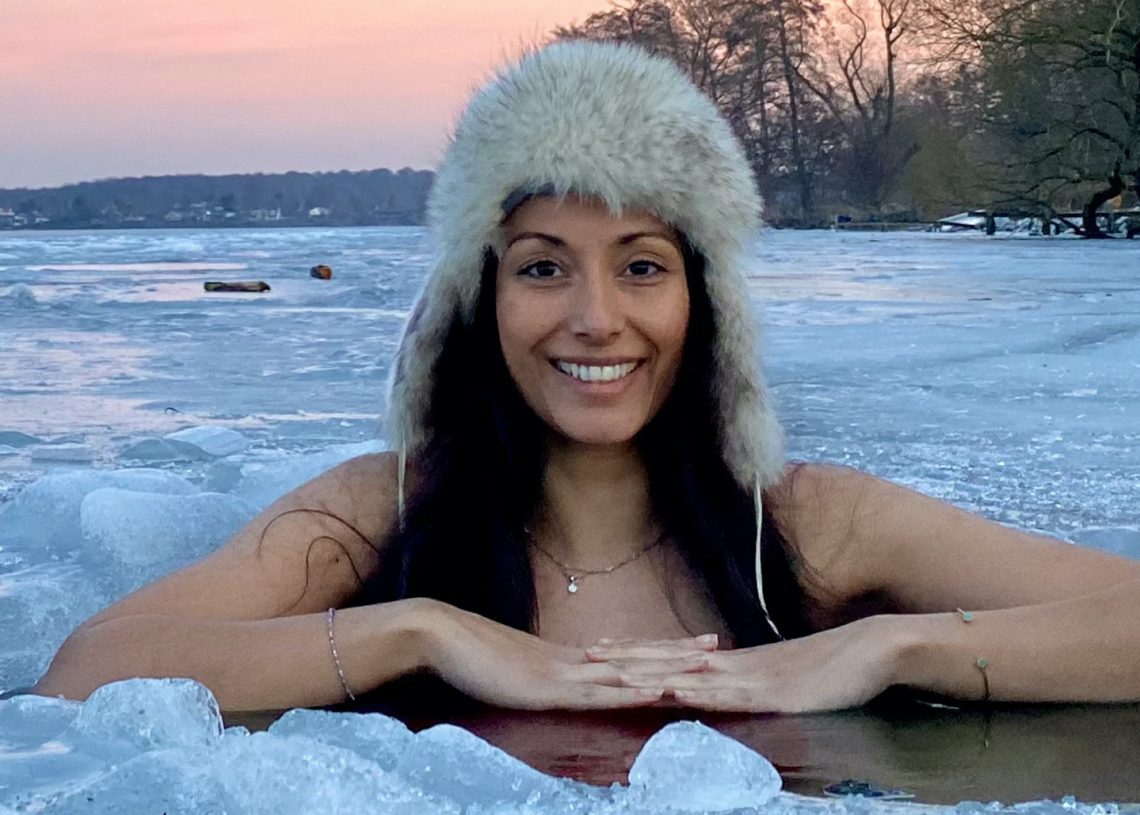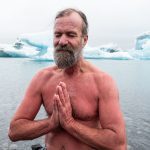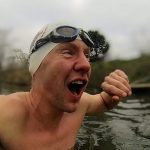
What happens to your body when you go cold-water swimming?
Is there an optimum amount of cold water swimming to develop brown fat? Dr Susanna Søberg shares her findings on what happens to your body when you go cold water swimming, including the activation of brown fat, better glucose balance and other health benefits. Watch our conversation with Dr Søberg – filmed as part of our virtual patron events.
“Brown fat is the opposite to white fat. White fat stores energy in the body and brown fat is quite the opposite: it uses energy in the body.” Dr Susanna Søberg, Outdoor Swimmer
In November, Outdoor Swimmer hosted a virtual conversation with Dr Susanna Søberg, author of Winter Swimming: The Nordic Way Towards a Healthier and Happier Life. Dr Søberg’s research showed her that brown fat plays an important metabolic function in the body. Furthermore, she discovered that cold water swimming helped the development of brown fat and could also improve its function.
Her work with cold water swimmers led her to taking up the activity herself in Denmark, despite being someone who always felt she wasn’t well adapted to cooler temperatures. She soon felt the same benefits to her mood and wellbeing that her study subjects reported.
Through her research, Dr Søberg developed a protocol for the optimum amount of immersion in cold water and found that 11 minutes per week was sufficient. In addition, she found that combining cold water immersion with heat exposure through a sauna could increase the benefits.
Dr Søberg – who joined the call from north of Copenhagen in Denmark – responded live to questions from patrons and subscribers, covering topics such as the ideal temperatures for feeling the benefit of cold water, common illnesses that should make you miss a cold swim, and whether you still get the benefits of cold water immersion when wearing a wetsuit.
Watch our full 1-hour conversation below or read our full interview with Dr Susanna Søberg from the November edition of Outdoor Swimmer.
The scientist and the swimmer: cold water enthusiast Jonathan Cowie talks to Dr Susanna Søberg, author of new book Winter Swimming – The Nordic Way Towards a Healthier and Happier Life
Although cold-water swimming might seem like the latest fad, it has a long tradition not only in this country but around the world. What is new is the growing body of research that is backing up long-held anecdotal evidence of the positive effects of cold water immersion with hard science.
Research is being conducted around the world into the positive psychological and physiological effects of cold-water swimming. In our October issue we reported on the social prescribing of wild swimming by GPs for the treatment of depression. This would have been unthinkable 15 years ago.
In the UK, research by Mike Tipton, Heather Massey, Mark Harper and others is extending our knowledge of the body’s reaction to cold water.
Meanwhile, Dr Susanna Søberg, whose new book Winter Swimming explores cold water traditions in Scandinavia and around the world, has been carrying out research in Denmark on why cold-water immersion provides such a boost for body and soul, in particular drawing on her background as an expert in metabolism to explain how our ‘brown fat’ is activated to benefit multiple health conditions.
What makes particularly interesting reading are the chapters explaining the science of cold-water immersion and what happens to your body when you go winter swimming. I spoke to Susanna about her research, and her new book that explores winter swimming and sauna culture.


Susanna, it’s interesting how science is now backing up what winter swimmers have always known about its health benefits. What came first for you, swimming or science?
Before I became a winter swimmer, I was intrigued by people jumping into the water. And we do that quite a lot in Denmark! I’d heard all the stories, but I’m data-driven and I thought, ‘there’s no evidence.’
So I didn’t want to jump in myself, but I did see that winter swimmers were so happy and they always told me how good it made them feel. My friends would ask me, “Do you want to come?” And I’d reply, “Maybe not today… maybe not ever!”
So what changed your mind?
I read about winter swimming and cold exposure, but it took me a while before I said to myself, “Okay, I have to jump into the water myself.” And that is how I started because I really wanted to see first-hand.
How did you get involved in research into winter swimming?
I began my research into the ‘sweet tooth’ but then switched to something quite different – a specialised mitochondria-rich tissue called brown fat. I didn’t know anything about it, but I was fascinated because I’m very much interested in basic science.
For someone who isn’t a scientist, what is brown fat and why is it so important?
Brown fat is the opposite to white fat. White fat is on your bottom and your belly, and you really want to get rid of any excess white fat you may have.
White fat stores energy in the body while brown fat is quite the opposite: it uses energy in the body. When you go into the cold, brown fat is activated by noradrenalin, which increases up to 250% within minutes.
Once activated, brown fat uses sugar and fat from the bloodstream as fuel to increase heat in your body. So the purpose of brown fat is to keep you warm and not die from hypothermia.
It is really clever of nature to give us this little radiator in your body. And this brown fat tissue will also keep you healthy because it uses suspended calories in your body and increases your insulin sensitivity.
White fat stores energy in the body while brown fat is quite the opposite: it uses energy in the body. When you go into the cold, brown fat is activated by noradrenalin, which increases up to 250% within minutes
Is there a difference between cold-water swimming and cold showers?
I found out that there were studies showing that if you sleep in a cold room for a month at 19 degrees, or if you wear a cooling vest at 14 degrees for 10 days ,you can activate your brown fat. But who wants to wear a cooling vest?
A cold shower or bath will activate your brown fat too, you just need to get cold. You can also go for a walk with a t-shirt in a cold wind if you’re into that!
I think a cold shower is great to get fresh and energised so you can get through the day, and probably skip a couple of cups of coffee too! But if you want a feeling of calmness and to get more mentally balanced, then a cold dip is better.
According to your research, how long should people be cold-water dipping to take advantage of its physical and mental health benefits?
I wanted to find a protocol that would be feasible for everyone, even for me who is very much a cold sissy! So I went to different clubs and interviewed people, asking them, ‘How do you do it? And how many minutes?’.
I calculated that two minutes, with a 250% increase in norepinephrine, is definitely enough activate brown fat. The increase in dopamine and serotonin, also very important for mental balance, also happens within these two minutes.
We know from the theories of Hans Selye, who discovered the stress system, that healthy stress is when you stress cells so they get stronger. But if you overdo it, they will get tired. Just like a tree grows stronger in the wind for the next wind to come, but if the wind is too strong, it will break. So if we spend too long in the water we reach the threshold for how much benefit we can get.
I think a cold shower is great to get fresh and energised so you can get through the day. But if you want a feeling of calmness and to get more mentally balanced, then a cold dip is better.
I love that your book features a photograph of a group of swimmers at Tooting Bec Lido, who were very influential in me starting my winter swimming journey. What role does community play in the benefits of winter swimming?
So that’s kind of a phenomenon. What is actually going on when people go in groups? What is it about this phenomenon that doing something together actually increases your mood and health?
When you go into the water you get cold water shock, which is your body triggering your survival instinct. Your whole body goes into panic mode. When you do this in a group and you are able to reduce your cold shock response, you achieve a calm state of mind where you transfer from the sympathetic activation to the parasympathetic activation.
Like our ancestors who hunted lions, we have survived a life-threatening situation. And I think that pushes people together.
Your book also explores Scandinavian sauna culture and the effect of heat on the body. What is your protocol for introducing heat as well as cold?
So I think the protocol for doing that is switching between the cold and the heat. I recommend that you have 11 minutes of cold per week in total, and 57 minutes of heat per week in total.
Divide into two to three days with rounds of: three cold dips and two sauna sessions. End on cold according to the Søberg Principle.
The health benefits are that you have increased cold resilience, higher brown fat activation, better glucose balance and increased insulin sensitivity.
The health benefits are increased cold resilience, higher brown fat activation, better glucose balance and increased insulin sensitivity.
Can you explain the Søberg Principle?
The Søberg Principle was defined by me, but named by Professor Dr Andrew Huberman, who interviewed me after my last scientific paper on winter swimmers.
Follow the Søberg Principle to increase your health benefits and keep your brown fat activated by ending with the cold – meaning not in the sauna!
If you go home cold you are still activating the brown fat and your muscles too. In time you of course get habituated to the cold, but that doesn’t mean you aren’t still getting the health benefits.
You started winter swimming as part of your research. Why do you keep swimming now?
My research shows just how healthy it is. It’s keeping me warmer, it’s increasing my metabolism and it’s also increasing my insulin sensitivity.
But it also does a lot of other things. It keeps me mentally balanced. If I have a stressful day and I go out and take a dip, it will completely take away all those worries. It’s a holistic way of keeping yourself mentally and physically healthy.
Dr Susanna Søberg’s new book ‘Winter Swimming: The Nordic Way Towards a Healthier and Happier Life’ is out now. Follow Susanna on Instagram @Susanna_Soeberg
This edited article originally featured in the November 2022 issue of Outdoor Swimmer.
For more guidance on cold-water swimming, click here.









